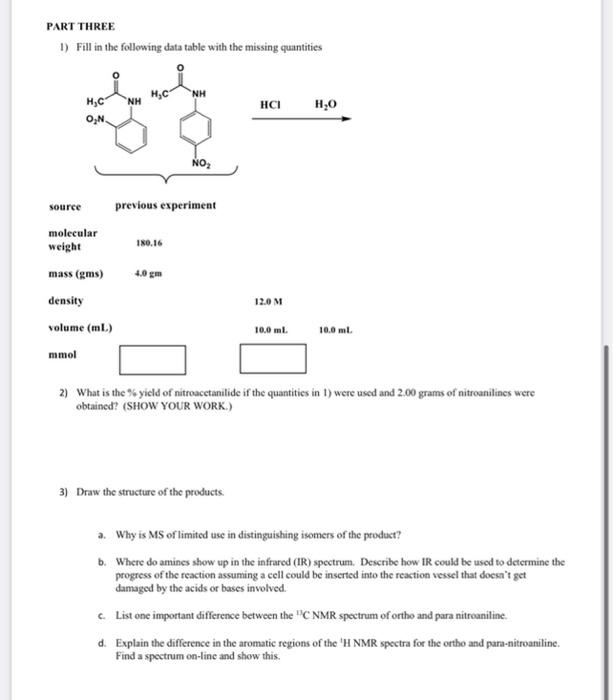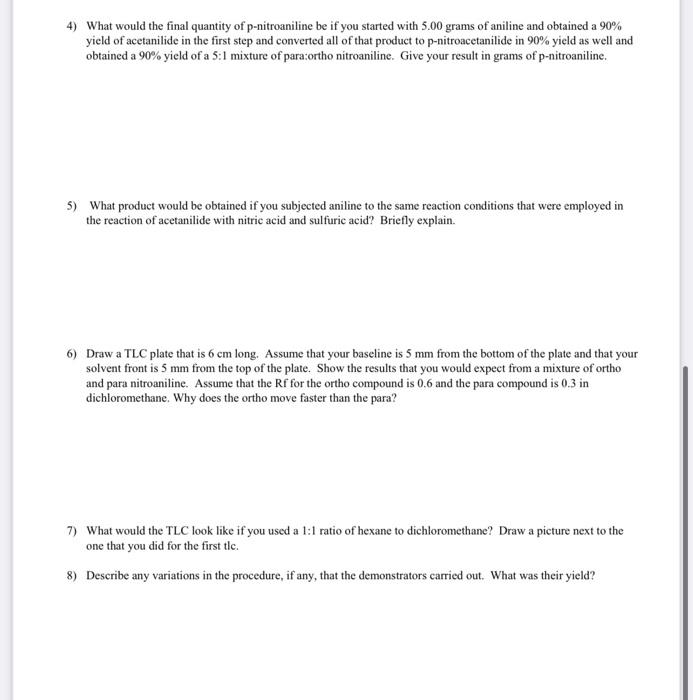Answered step by step
Verified Expert Solution
Question
1 Approved Answer
Please do all the questions. Thank you PART THREE 1) Fill in the following data table with the missing quantities O HC NH NH HC
Please do all the questions. Thank you 

PART THREE 1) Fill in the following data table with the missing quantities O HC NH NH HC ON HCI H20 NO source previous experiment 180.16 molecular weight mass (gms) 4.0 gm 12.0 M density volume (ml) mmol 10.0 ml 100 ml 2) What is the %yicld of nitroacetanilide if the quantities in 1) were used and 2.00 grams of nitroanilines were obtained? (SHOW YOUR WORK.) 3) Draw the structure of the products. a. Why is MS of limited use in distinguishing isomers of the product? b. Where do amines show up in the infrared (IR) spectrum. Describe how I could be used to determine the progress of the reaction assuming a cell could be inserted into the reaction vessel that doesn't get damaged by the acids or bases involved. c. List one important difference between the "C NMR spectrum of ortho and para nitroaniline. d. Explain the difference in the aromatic regions of the 'H NMR spectra for the ortho and para-nitroaniline. Find a spectrum on-line and show this. 4) What would the final quantity of p-nitroaniline be if you started with 5.00 grams of aniline and obtained a 90% yield of acetanilide in the first step and converted all of that product to p-nitroacetanilide in 90% yield as well and obtained a 90% yield of a 5:1 mixture of para-ortho nitroaniline. Give your result in grams of p-nitroaniline. 5) What product would be obtained if you subjected aniline to the same reaction conditions that were employed in the reaction of acetanilide with nitric acid and sulfuric acid? Briefly explain. 6) Draw a TLC plate that is 6 cm long. Assume that your baseline is 5 mm from the bottom of the plate and that your solvent front is 5 mm from the top of the plate. Show the results that you would expect from a mixture of ortho and para nitroaniline. Assume that the Rf for the ortho compound is 0.6 and the para compound is 0.3 in dichloromethane. Why does the ortho move faster than the para? 7) What would the TLC look like if you used a 1:1 ratio of hexane to dichloromethane? Draw a picture next to the one that you did for the first tlc. 8) Describe any variations in the procedure, if any, that the demonstrators carried out. What was their yield 

Step by Step Solution
There are 3 Steps involved in it
Step: 1

Get Instant Access to Expert-Tailored Solutions
See step-by-step solutions with expert insights and AI powered tools for academic success
Step: 2

Step: 3

Ace Your Homework with AI
Get the answers you need in no time with our AI-driven, step-by-step assistance
Get Started


